
Art Deco Light Switches and Covers
"For interior design, a light switch is like a pocket square on a Sunday suit. It’s not usually big or expensive, but it can do a lot to accent the whole." ("The evolution of a light switch", Frostdale Company website, gathered 4-14-25)
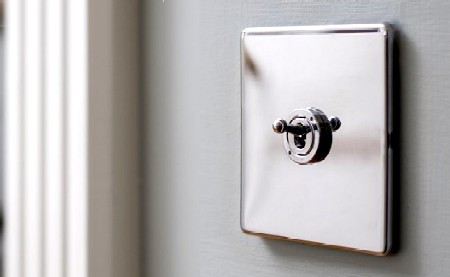
Light Switches, Chromed Toggle Switch, Modern Design, Vintage Style, Elesi UK
Did you ever wonder about the style of switches which would have been popular during the Art Deco and Streamline Moderne eras? This can be of concern for those looking to recreate these styles in their homes. This page provides a bit of history on the humble light switch including how (and why) it developed the way it did. First it is worth considering the background against which light switches appeared.
The first home to be electrified was in Appleton, Wisconsin in September 1882. It was direct current powered with hydroelectricity as the source. Following years of debate, AC current became the standard, with Nicholas Tesla and George Westinghouse's Alternating Current system beating beating Thomas Edison and General Electric's DC current system in 1893 at the Chicago World’s Fair. (It was much more involved than this, but no sense getting mired in the details. The focus here is on wall switches, after all.) "By 1925, half of all American homes had electric light (National Park Service). By the end of the 1930s, two-thirds of all British homes had them (Science Museum). Other countries followed their own path, many of them right in step with the US and the UK." (Lori Davis, "Let There Be Light: A History of Flipping the Switch", Her Half of History website, gathered 4-13-25)
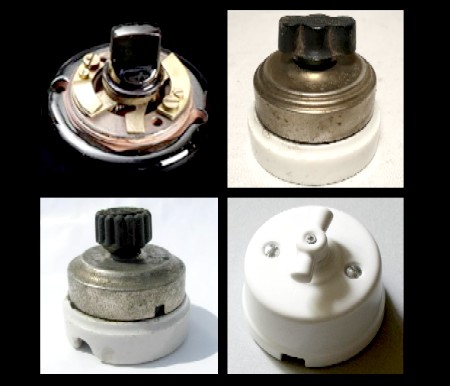
Four Styles of Rotary Light Switches
The earliest method of home electrification relied on bare copper wires with minimal cotton insulation with sockets and switches being made of wood. Between 1890 and 1910, electricity used the knob and tube system with the hot and neutral wires being separated and coated with rubberized cloth. (My house dates to 1911 and still had some knob a tube wires with ceramic insulators before I rewired it.) During the Art Deco era, flexible armored cable was used, providing more protection from wire damage. Beginning in the 1940s, metal conduit was used encasing insulated wires. Beyond the Art Deco era, home wiring began to be grounded in 1965, making the system much safer.
In the beginning, lights were turned on either by manually plugging them in or through rotary switches. The earliest electrical switch is believed to have been invented by Edison for the New Year celebrations of 1880. Unfortunately there are no extant images of this system. The American History Museum says that Edison created the rotary light switch in 1882, which would coincide with the electrification of the Wisconsin house. These were turned to open and close the circuit. They were simple, often made of brass, porcelain, or bronze. (See the image above left.)
In 1883, English electrical engineer John Henry Holmes installed electric lighting in his family home in Newcastle.
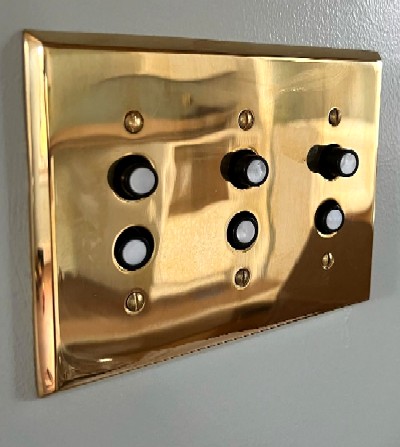
Pushbutton Light Switch, Facebook
He created the quick break switch to turn the electricity on and off, patenting his invention in both Great Britain and the United States in 1884. (To see a picture of his original design and an article about Holmes, click on this link.)
Holmes' invention ensured that the contacts would separate or come together very quickly, however much or little pressure was exerted by the user on the switch actuator. The action of this 'quick break' mechanism meant that there was insufficient time for an arc to form, and the switch would thus have a long working life. This 'quick break' technology is still in use in almost every ordinary light switch in the world today, numbering in the billions, as well as in many other forms of electric switch. ("Light switch", Wikipedia, gathered 4-13-25)
Pushbutton light switches appeared between 1884 and 1890. They featured two buttons, one to connect a circuit and turn on a light on and the other to turn it off. Pressing one caused the other to mechanically pop up. The pushbutton light switch was based on Holmes' original design concept although they had a much cleaner appearance. A version of the pushbutton switch with a dimmer was created in 1890 for use in movie theaters by Granville Woods. These were installed in homes during the late 19th and early 20th century. See the image at right for a modern reproduction of a triple gang pushbutton switch.
The pull chain switch, which has a bead chain connected directly to the light socket, was invented in 1896 by Harvey Hubbell II of Connecticut. Hubbell also invented a variety of plug outlets include those with round pins (patented 1903), co-planer aligned flat pins (1904) and the parallel aligned flat pins (1912). The last design is what is in use in in America today
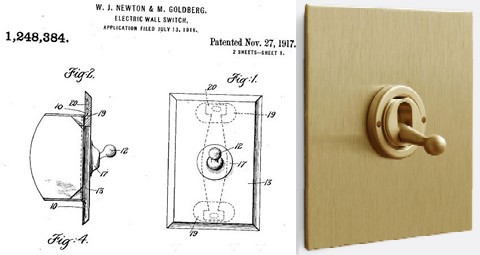
Newton's 1916 Patent Application, and a Modern Reproduction Toggle Switch, Rejuvination and Frostdale
The toggle light switch, which is the manual light switch which most people probably think of today and which is preferred in most countries today, was patented in 1917 by William J. Newton and Morris Goldberg in New York. See the fourth image below for drawings from the patent and an example of the switch style. Some suggest it was orgiinally invented in 1897. This design does not control the contacts directly, but uses a spring which closes them once the switch passes the center point. "While original toggle switches still required some force to flip and made a sharp snapping noise, they were considered easier to use than pushbutton switches, and did not have the same tendency to stick as push buttons sometimes did." (While original toggle switches still required some force to flip and made a sharp snapping noise, they were considered easier to use than pushbutton switches, and did not have the same tendency to stick as push buttons sometimes did.)
All of these designs were around
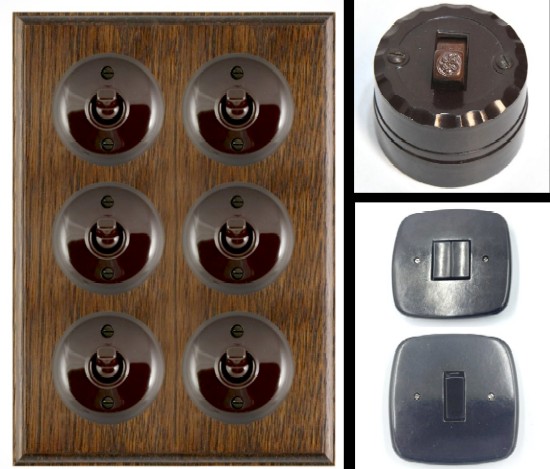
Bakelite Toggle Switches, 1920s Reproduction, GE (From Ebay) and 1940s Original
during the 1920s and 30s. Although one author above suggested that the push button design was popular in the wealthy homes, I have not found this in any of the several other histories of light switches. One material which began gaining traction among some light switch makers beginning in the 1920s was Bakelite. It was at first used with the popular porcelain in rotary switches, but also began being used with the new toggle switches in the 1920s according to one manufacturer who reproduces them based on a design they date to that era. (See the fifth image below.) However, push button switches do have a certain nostalgic panache that the now ubiquitous toggle switch. So there are a variety of switch choices available.
Of course, there is also a less expensive option to changing out all the functioning light switches in a house to more expensive (not to mention noisier and somewhat less reliable) switches. Simply use modern light switches with Art Deco style light switch face plates. While not strictly accurate to the period, it will save a lot of money and work and still give the general effect. For ideas on that see ideas for American switch plates. For the American market, there are a wide variety of such options.
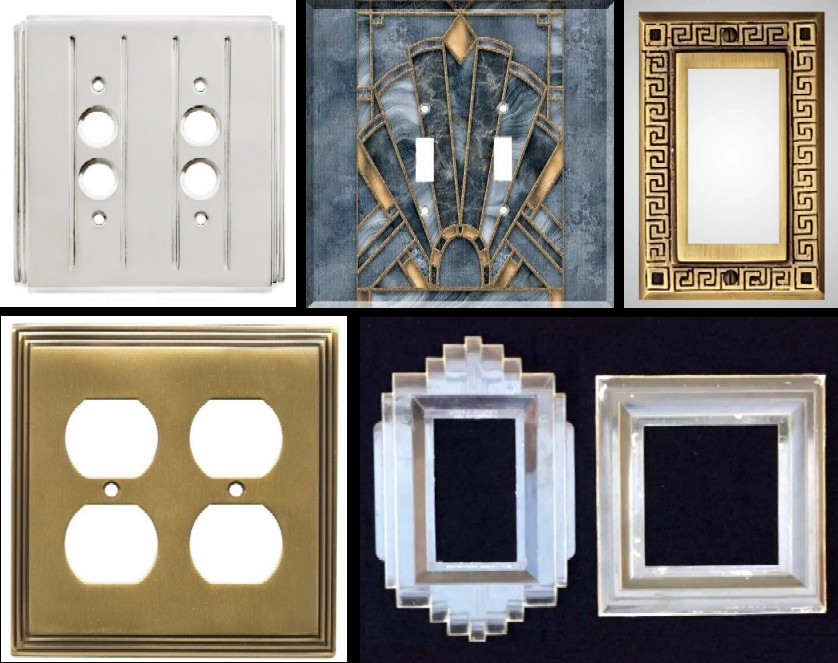
American Light Switch Covers and Surrounds, From left: Streamline Pressed Brass Push Button Switch Plate, House of Antique Hardware; Stained Glass Gray Print Light, Ebay; Greek Key Design, Gold, Modern, Magnus Home Products; Stepped Antique Brass, Modern, Switch Hits; Surrounds, Clear 'Protect-o-Shield' by Gits Molding Company, 1920s or 30s, Worthpoint
Not to be left out, non-American markets tend to offer more limited product lines, but there are some simple, elegant faceplates which, combined with a bit of ingenuity, can work just as well. People in the UK sometimes use light switch surrounds to get more of an Art Deco stepped feeling. The last image below is an example of how a surround can be placed behind a regular plastic switch to give it more of an Art Deco feel.
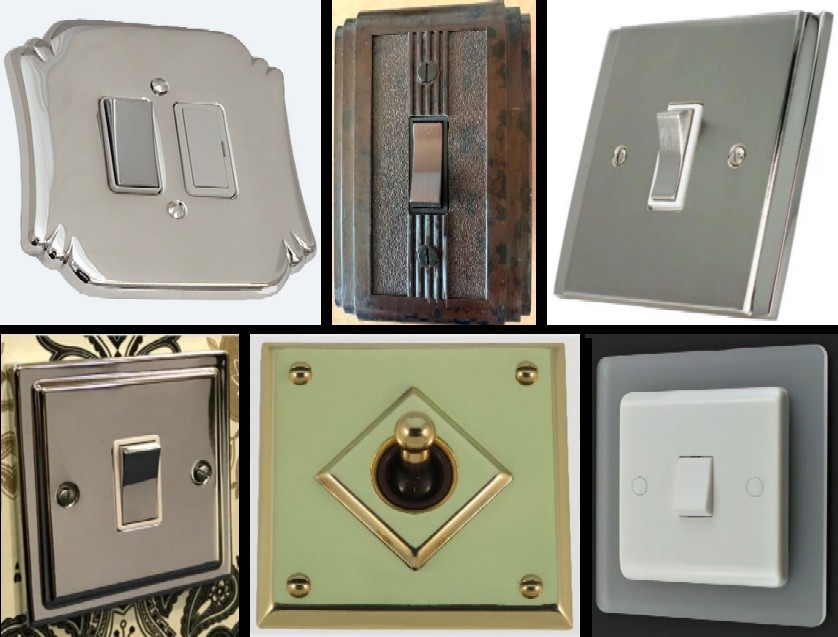
Non-American Light Switch Covers and Surrounds, From left: Liberty Switch, Polished Chrome, UK, Modern, Cheshire Hardware.; Bakelite Cover and Switch for Architrave Box, Wandsworth, Vintage, Ebay; Satin Nickel Switch Plate, UK, Modern, Sockets and Switches; Art Deco Classic Polished Crome, Modern, Sockets and Switches; Black-Bronze Series 10 Small Switch, Australia, Modern, Classic Electric Switch Co.; Perspex Switch Stepped Surround, Etsy
Original Facebook Group Post
Sources Not Mentioned Above:
"History of AC power plugs and sockets", Wikipedia, gathered 4-14-25
"The History of Electricity | History of Electricity Timeline", Mr. Electric website, gathered 4-13-25
Julia Timlin, "Origins of the Light Switch", Sunco website, gathered 4-13-25
"How was the Light Switch Invented and Made", Yicheng Automation website, gathered 4-13-25
Connor Herring, "History of the Light Switch as researched by Trendi Switch", Trendi Switch website, gathered 4-13-25
"John Henry Holmes: electrical leading light", Heaton History Group, gathered 4-13-25
Katie Maggs, "What's in store: how First Time Out opened our eyes to new possibilities", The Guardian website, gathered 4-13-25
"Rotary Electric Light Switch", National Museum of American History, gathered 4/13/25
"Facts & Info - Old-style switches", Sekelskifte website, gathered 4-14-25
Megan Reed, "Why Vintage Push Button Are Making a Comeback", Residence Supply website, gathered 4-14-25